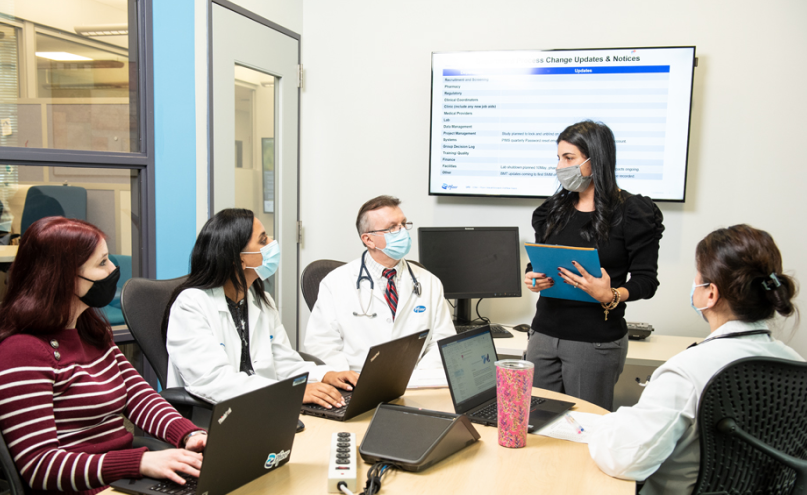- Study team
A clinical trial is no small undertaking and involves dedication from a large, diverse team. It involves the study sponsor, principal investigator, study coordinator, and most importantly, the participants themselves — all working together to help bring new medicines and vaccines to market.
- Informed consent
Informed consent is a process to ensure that participants are fully informed about their specific studies before deciding to take part in them. The study team reviews the details of the study with the participant, including possible risks and benefits, and answers any questions about the informed consent document(s) before they agree to participate and sign.
Where Science Meets Patients
How Clinical Trials
Help Advance
Medicine
By Sachi Fujimori | March 2022

How do scientific discoveries move from the lab to our pharmacy shelves? This journey is known as drug development, and clinical trials are a key part of the process. In fact, without these research studies, we would have no new medicines or vaccines.
Clinical trials are also truly a joint effort. From the thousands of patients who volunteer each year to the scientists, clinicians, and principal investigators (PIs), each individual who contributes to a trial helps to bring about life-changing treatments and advances our knowledge of diseases.
Let’s follow one patient’s journey in a clinical trial and meet some of the main people who work behind the scenes to help make trials happen.
Starting with a patient’s
unmet need
In 2013, as a recent college graduate, Eric was diagnosed with ulcerative colitis (UC), a form of inflammatory bowel disease, that put his life on hold. Like many patients with this chronic condition, he struggled with unpredictable flare-ups that caused severe abdominal cramps, bloody stools, and a sudden, urgent need to use the restroom.

Working with his healthcare team for over a year, Eric tried all the available therapies, but his symptoms only grew worse. As a last resort, he considered undergoing an aggressive surgery to remove his entire colon.
But after joining a specialty clinic at Houston Medical Center, his doctor told him about a clinical trial for an experimental therapy to treat UC. With the support of his mom (a former nurse) and his girlfriend Kelly (now his wife), he decided to enroll. “For me there was no other alternative. It was either get my entire colon cut out or give this a shot,” says Eric.
Translating scientific
innovation into medicines
Ask any scientist who develops medicines and vaccines about what motivates them to keep going in the lab; their resounding answer is to make an impact on patients like Eric, who struggle with debilitating diseases.
And it takes a vast team of scientists with different specializations and many years of persistence to develop investigational medicines that eventually can be evaluated in a clinical trial. Some early researchers are focused on better understanding the biology of diseases, while others are experts in computer modeling that can match a potential medicine to the right patient population.

We are continuously exploring novel mechanisms that can be leveraged to bring transformative medicines to patients and address unmet medical need.
Designing trials
with patients at the center
Before an investigational medicine or vaccine is evaluated in clinical trials, a clinician must develop the protocol or the study plan.
Clinical trials are usually conducted in four phases. Each phase has a different purpose that helps scientists answer research questions.
There are many factors to consider when developing a study plan. What is the specific patient population? What end points or outcomes will be measured; e.g., a tumor shrank, a patient was able to walk. Getting all these factors right in the trial design is critical to a successful clinical study.

We want to make sure that our clinical trials generate data that enables us to make a robust decision, one way or another, about the safety and effectiveness of a potential medicine.
Pfizer researchers have been at the forefront of adopting novel trial designs and technologies and using patient input in the design process. When defining the study’s end points, in addition to clinical end points, researchers are looking to measure things that matter to the patient — for example, does a potential medicine impact outcomes that measure improvements in quality of life? Trials are also being designed to make participation as convenient as possible. This could mean enabling participants to do their lab work closer to home or to conduct their health assessments virtually.
“There are a variety of tools, such as using real-world data, which remove the need to capture data again that already exists in the medical record,” says Scholfield. “More efficient trials mean that we can get the answers we need more quickly while maintaining quality, and still have the same robust outcomes.”
Working as a team to improve
the patient experience
In 2014, Eric began the screening process to participate in his clinical trial. First, he met with members of the study team, and went through the informed consent process, where he learned about his rights as a patient and the risks and benefits of participating. Once he decided he wanted to enroll and signed consent forms, he had to undergo some medical screenings. The study doctor then confirmed his eligibility to participate in the study.1 The entire process for joining the study took a few weeks, he says.
1 Each clinical trial has eligibility requirements about who can participate. These may include a person’s age, sex, type and stage of disease, and overall health. To learn more visit here.
- Screening
During screening, a patient visits the study doctor’s office to confirm eligibility criteria and determine if they’re able to participate. This includes a detailed review of the patient’s medical history and a physical exam and may include blood work and additional tests required by the clinical trial.
It takes a broad team to successfully run a clinical trial. Meet some of the experts who are behind these efforts. Learn about the different people who make trials happen.

Initially, Eric had to visit the study site every few weeks, but eventually these prescheduled visits tapered to a quarterly basis.
And communication with his study team, Eric says, was easy and transparent. Whenever he needed, he could contact his research coordinator to ask questions or schedule visits.
Safeguards to protect
patient participants
Every clinical trial has an institutional review board (IRB), an independent group that includes scientists, doctors, and data and safety monitoring board (DSMB) members who review and monitor the trial to ensure the protection of patients’ rights, as well as their safety.
Moving science forward
Since enrolling in his clinical trial over seven years ago, Eric says it helped bring joy, success, and normalcy back into his life. “It's important for patients to know there is hope,” he says.
He also feels pride in being part of a broader scientific endeavor.

“It’s a two-way street. Individually, participating in this clinical trial benefited me. But through my success, I’ve also had the ability to maybe give hope and life back to somebody.”
As for the multidisciplinary team, they also hope to make an impact.
“I look into the future and think, How do we make a brighter future for the next generation for this generation? I know that today we don't have all the answers and without clinical trials we won't find new ones.”
Science has always been about collaboration. And clinical trials are the greatest example of that —volunteers, researchers, clinicians, and more come together for the common mission of making a positive impact on patients’ lives. Each and every person involved in a clinical trial plays a powerful role in helping to create new medicines and vaccines. These shared efforts offer hope for many patients today, as well as for future generations.





